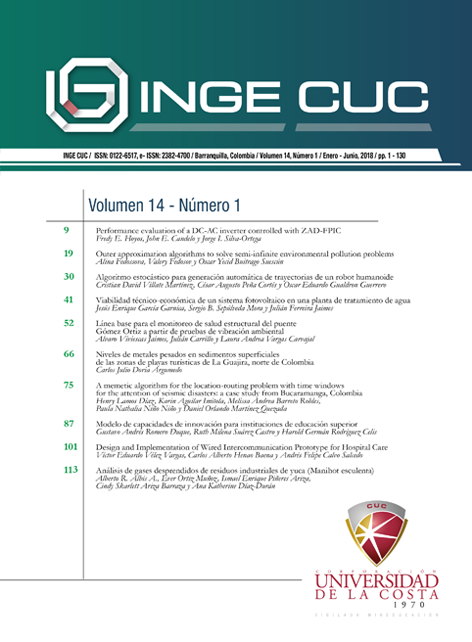Stochastic algorithm for automatic path planning of a humanoid robot
DOI:
https://doi.org/10.17981/ingecuc.14.1.2018.03Keywords:
Humanoid Robots, Path Planning, Autonomous RobotAbstract
Introduction: The incorporation of an autonomous learning system in robotics will allow the resolution of a large number of problems. One is the autonomous march of the humanoid robots due to its complexity in the great number of variables regarding this process.
Objective: Develop algorithms that generate autonomous paths in a humanoid robot with various degrees of freedom.
Methodology: The study begins with the development of stochastic algorithms with few dimensions. Then, it will be extended to n-dimensional situations. Afterward, simulation tests will be carried out. And finally, the experimental tests are performed.
Results: An algorithm was generated based on the physical model of the robot to create walking paths stochastically. A simulator that contemplates the kinematic constraints, including collisions, was implemented to verify the results. In addition, one hundred experimental tests were done. With these tests, the correct operation of the trajectories was verified.
Conclusions: It was verified that it is possible to create a stochastic algorithm that mixes determinant and random rules to automatically generate paths in humanoid robots, hence, extending concepts generated in two-dimensional and three-dimensional spaces to n-dimensional articulated coordinates.
Downloads
References
[2] G. Wiedebach et al., “Walking on partial footholds including line contacts with the humanoid robot atlas,” in IEEE-RAS International Conference on Humanoid Robots, pp. 1312–1319, 2016. DOI: 10.1109/HUMANOIDS.2016.7803439 URL: https://ieeexplore.ieee.org/document/7803439/
[3] B. Ding, A. Plummer y P. Iravani, “Investigating Balancing Control of a Standing Bipedal Robot With Point Foot Contact,” IFAC-PapersOnLine, vol. 49, no. 21, pp. 403–408, 2016. DOI: http://dx.doi.org/10.1016/j.ifacol.2016.10.587
[4] E. ; Ackerman y E. Guizzo, “Its Wheel-Leg Robot: ‘Best of Both Worlds,’” IEEE Spectrum, 2017. [En línea]. Disponible en: https://spectrum.ieee.org/automaton/robotics/humanoids/boston-dynamics-handle-robot. [Accessed: 20-Jul-2017] URL: https://spectrum.ieee.org/automaton/robotics/humanoids/
boston-dynamics-handle-robot
[5] Y. Hosoda, S. Egawa, J. Tamamoto, K. Yamamoto, R. Nakamura y M. Togami, “Basic design of human-symbiotic robot EMIEW,” in IEEE International Conference on Intelligent Robots and Systems, no. c, pp. 5079–5084, 2006. DOI: 10.1109/IROS.2006.282596. URL: http://ieeexplore.ieee.org/document/4059227/
[6] B. Henze, A. Dietrich y C. Ott, “An Approach to Combine Balancing with Hierarchical Whole-Body Control for Legged Humanoid Robots,” IEEE Robotics and Automation Letters, vol. 1, no. 2, pp. 700–707, 2016. DOI: 10.1109/LRA.2015.2512933. URL: http://ieeexplore.ieee.org/document/7368116/
[7] Y. Liu, P. M. Wensing, J. P. Schmiedeler y D. E. Orin, “Terrain-Blind Humanoid Walking Based on a 3-D Actuated Dual-SLIP Model,” IEEE Robotics and Automation Letters, vol. 1, no. 2, pp. 1073–1080, 2016. DOI: 10.1109/LRA.2016.2530160. URL: http://ieeexplore.ieee.org/document/7407320/
[8] M. W. Clearfield, “Learning to walk changes infants’ social interactions,” Infant Behavior and Development, vol. 34, no. 1, pp. 15–25, 2011. DOI: 10.1016/j.infbeh.2010.04.008. URL: http://dx.doi.org/10.1016/j.infbeh.2010.04.008
[9] E. P. Shaw et al., “Measurement of attentional reserve and mental effort for cognitive workload assessment under various task demands during dual-task walking,” Biological Psychology, vol. 134, no. January, pp. 39–51, 2018. DOI: 10.1016/j.biopsycho.2018.01.009. URL: http://linkinghub.elsevier.com/retrieve/pii/S0301051118300413
[10] K. B. Lee, H. Myung y J. H. Kim, “Online multiobjective evolutionary approach for navigation of humanoid robots,” IEEE Transactions on Industrial Electronics, vol. 62, no. 9, pp. 5586–5597, 2015. DOI: 10.1109/TIE.2015.2405901. URL: http://ieeexplore.ieee.org/document/7047860/
[11] D. A. López, J. E. Hernández y C. A. Peña Cortes, “Advances in the control of bipedal platforms using
the system,” Revista Colombiana de Tecnologías de Avanzada, vol. 2, pp. 117–124, 2013. DOI: https://doi.
org/10.24054/16927257.v22.n22.2013.419. URL: http://revistas.unipamplona.edu.co/ojs_viceinves/index.php/RCTA/article/view/419
[12] K. Teachasrisaksakul, Z. Q. Zhang, G. Z. Yang y B. Lo, “Imitation of dynamic walking with bsn for Humanoid robot,” IEEE Journal of Biomedical and Health Informatics, vol. 19, no. 3, pp. 794–802, 2015. DOI: 10.1109/JBHI.2015.2425221. URL: http://ieeexplore.ieee.org/document/7096914/
[13] A. Barrientos, L. Peñin, C. Balager y R. Aracil, Fundamentos de Robótica, 2nd ed. Madrid: McGraw-Hill, 2007.
[14] E. Luhta, “Walk Cycles,” in How to Cheat in Maya 2010, Boston: Focal Press, pp. 177–221, 2010. DOI: 10.1016/B978-0-240-81188-8.50008-4. URL: http://linkinghub.elsevier.com/retrieve/pii/B9780240811888500084
[15] K. H. Koch, K. Mombaur y P. Soueres, “Optimizationbased walking generation for humanoid robot,” in IFAC Proceedings Volumes (IFAC-PapersOnline), vol. 45, no. 22, pp. 498–504, 2012. DOI: 10.3182/20120905-3-HR-2030.00189. URL: http://dx.doi.org/10.3182/20120905-3-HR-2030.00189
[16] J. V. Nunez, A. Briseno, D. A. Rodriguez, J. M. Ibarra y V. M. Rodriguez, “Explicit Analytic Solution for Inverse Kinematics of Bioloid Humanoid Robot,” in 2012 Brazilian Robotics Symposium and Latin American Robotics Symposium, pp. 33–38, 2012. DOI: 10.1109/SBR-LARS.2012.62. URL: http://ieeexplore.ieee.org/document/6363315/
[17] P. Wawrzynski, J. Mozaryn y J. Klimaszewski, “Robust estimation of walking robots velocity and tilt using proprioceptive sensors data fusion,” Robotics and Autonomous Systems, vol. 66, pp. 44–54, 2015. DOI: 10.1016/j.robot.2014.12.012. URL: http://dx.doi.org/10.1016/j.robot.2014.12.012
[18] L. W. Tsai, Robot Analysis: The Mechanics of Serial and Parallel Manipulators. Maryland, USA: Wiley, 1999. URL: http://www.wiley.com/WileyCDA/WileyTitle/productCd-0471325937.html
[19] J. Zhao, Z. Feng, F. Chu y N. Ma, “A Brief Introduction to Screw Theory,” in Advanced Theory of Constraint and Motion Analysis for Robot Mechanisms, pp. 29–79, 2014. DOI: 10.1016/B978-0-12-420162-0.00002-3. URL: http://www.sciencedirect.com/science/article/pii/B9780124201620000023
Downloads
Published
How to Cite
Issue
Section
License
Published papers are the exclusive responsibility of their authors and do not necessary reflect the opinions of the editorial committee.
INGE CUC Journal respects the moral rights of its authors, whom must cede the editorial committee the patrimonial rights of the published material. In turn, the authors inform that the current work is unpublished and has not been previously published.
All articles are licensed under a Creative Commons Attribution-NonCommercial-NoDerivatives 4.0 International License.



 English
English
 Español (España)
Español (España)






















